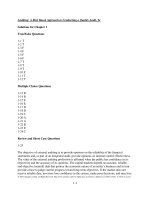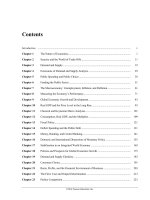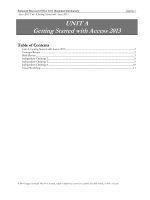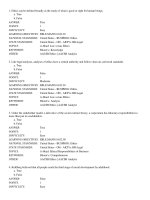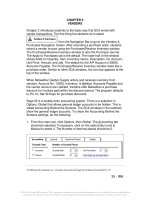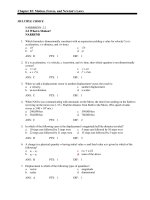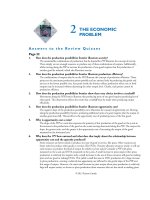Test bank and solution manual of economics US (1)
Bạn đang xem bản rút gọn của tài liệu. Xem và tải ngay bản đầy đủ của tài liệu tại đây (611.45 KB, 8 trang )
Chapter 02 - The U.S. Economy
ANSWERS TO QUESTIONS FOR DISCUSSION AND
PROBLEMS
QUESTIONS FOR DISCUSSION
1. Americans already enjoy living standards that far exceed world averages. Do we have
enough? Should we even try to produce more?
LO: 2
AACSB: Ethics
BT: Create
The reality of human nature is that needs are culturally conditioned. There is never
enough. Just to maintain living standards as population grows will require more
output.
2. Why do we measure output in value terms rather than in physical terms? For that
matter why do we bother to measure output at all?
LO: 1
AACSB: Analytic
BT: Analyze
Our economy produces thousands of different items, ranging from paper clips to
sophisticated electronic equipment. Value estimates are a common denominator for
measuring all of these different things. In addition, in our complex and
decentralized market economy, it is impossible to account for every item of output
produced. Sales records are more available for estimates of value than are output
numbers across the economy. Measures of output provide benchmarks that show if
growth is occurring and at what rate.
3. Why do people suggest that the United States needs to devote more resources to
investment goods? Why not produce just consumption goods?
LO: 3
AACSB: Reflective Thinking
BT: Analyze
Investment goods are capital goods such as machines and factories that help us
produce more output. If we concentrated on only consumption goods, we would be
unable to replace our machines as they wore out or to expand our productive
capacity by producing more, and more efficient, machines.
4. The U.S. farm population has shrunk by over 25 million people since 1900. Where
did they all go? Why did they move?
LO: 4
AACSB: Analytic
BT: Analyze
They went to the cities to become factory workers and service workers because
there were jobs available for them in those sectors of the economy. There were
fewer and fewer jobs in the agricultural sector because of the advances of
technology in that sector.
5. Rich people have over 15 times as much income as poor people. Is that fair? How
should output be distributed?
2-1
Copyright © 2014 McGraw-Hill Education. All rights reserved. No reproduction or distribution without the prior written consent of McGraw-Hill
Education.
Chapter 02 - The U.S. Economy
LO: 5
AACSB: Ethics
BT: Create
Fair is generally considered to be a relative term. On an individual basis, many
would consider it ‘fair’ if they personally received more or if someone else received
less. In a market economy, the distribution of output (and therefore income) is
determined primarily by the laws of supply and demand. This often results in an
unequal distribution. However, in order to make sure that the distribution is not so
unequal that we have people literally starving to death in the streets, the
government steps in and lessens the degree of inequality through various programs
and tax policies. Thus, at some point, fairness does become less subjective and more
objective when the inequality causes lives being put at risk, which, once recognized,
results in a redistribution of income.
6. If taxes were more progressive, would total output be affected?
LO: 5
AACSB: Analytic
BT: Analyze
Taxes create a disincentive to engage in any activity that is being taxed. If taxes
were more progressive, people who face the higher taxes would have less incentive
to work. As a result, total output would decline.
7. Why might income inequalities diminish as an economy develops?
LO: 5
AACSB: Analytic
BT: Analyze
As an economy develops, more jobs become available and thus more people will
work and earn incomes. There will also be more capital available and therefore
labor productivity – and income of workers – will rise. Although incomes will not
likely be equalized, on average there should be, and generally is, less income
disparity.
8. Why is per capita GDP so much higher in the United States than in Mexico?
LO: 3
AACSB: Analytic
BT: Analyze
Per capita GDP in the U.S. was $49,000 in 2012, almost five times the world
average, and more than three times Mexico’s per capita GDP. Thus, the average
U.S. worker produces about three times as much, when measured in dollars, as the
average Mexican worker. This is largely caused by the higher productivity
capabilities of the U.S. workers resulting from more education, better technology
and management practices.
9. Do we need more or less government intervention to decide WHAT, HOW, and FOR
WHOM? Give specific examples.
LO: 4
AACSB: Reflective Thinking
BT: Create
2-2
Copyright © 2014 McGraw-Hill Education. All rights reserved. No reproduction or distribution without the prior written consent of McGraw-Hill
Education.
Chapter 02 - The U.S. Economy
It really depends on the type of goods and services society would like to see
provided. Some products such as clean water and clean air are not usually
provided well by private markets and more government intervention might be
desired. Other products such as computers, food, etc., are usually best provided by
markets and less government intervention might be desired.
10. POLICY PERSPECTIVES What can poor nations do to raise their living
standards?
LO: 3
AACSB: Reflective Thinking
BT: Create
This is a complicated issue. A few of the things that poor nations can do to raise
their living standards include increasing their investment/consumption ratio,
investing in human capital, and reducing illiteracy. Many believe that poor nations
will need the assistance of the rich nations of the world to achieve this goal.
PROBLEMS
1. Draw a production-possibilities curve with consumer goods on one axis and
investment goods on the other axis.
(a) Identify the opportunity cost of increasing investment from I1 to I2.
(b) What will happen to future production possibilities if investment increases now?
(c) What will happen to future production possibilities if only consumer goods are
produced now?
Answers:
(a) the reduced consumer goods of C1 to C2
(b) production possibilities will increase, shifting the ppc to the right
(c) production possibilities will decrease, shifting the ppc to the left
2-3
Copyright © 2014 McGraw-Hill Education. All rights reserved. No reproduction or distribution without the prior written consent of McGraw-Hill
Education.
Chapter 02 - The U.S. Economy
Explanation:
(a) The opportunity cost of increasing investment is the loss of consumer goods.
Specifically, when investment increases from I1 to I2 consumption goods decrease
from C1 to C2.
(b) Investment goods include the plant, machinery, and equipment that are produced
for use in the business sector. If investment increases it will improve our stock of
capital, and will expand our production possibilities, shifting our curve to the right.
(c) Consumer goods include everything consumers buy. If only consumer goods are
produced, equipment and factories (for example) will not be replaced and production
possibilities will diminish leading to a shift to the left in the curve.
LO 02-01
Topic: What America Produces
AACSB: Analytic
Blooms: Level 4 Analyze
2. Suppose the following data describe output in two different years:
Item
Apples
Bicycles
Movie rentals
Year 1
20,000 @ $0.25 each
700 @ $800 each
10,000 @ $1.00 each
Year 2
30,000 @ $0.30 each
650 @ $900 each
12,000 @ $1.50 each
(a) Compute nominal GDP in each year.
(b) By what percentage did nominal GDP increase between Year 1 and Year 2?
(c) Now compute real GDP in Year 2 by using the prices of Year 1.
(d) By what percentage did real GDP increase between Year 1 and Year 2?
Answers:
(a) Year 1 = $575,000 Year 2 = $612,000
(b) 6%
(c) $539,000
(d) 6%
Explanation:
(a) Nominal GDP is the value of output measured in current prices. In Year 1
nominal GDP is $575,000 (= (20,000 x $0.25) + (700 x $800) + (10,000 x $1.00)).
In Year 2 nominal GDP is $612,000 (= (30,000 x $0.30) + (650 x $900) + (12,000 x
$1.50)).
(b) Nominal GDP increased from $575,000 to $612,000, or 6% (= ($612,000 $575,000) / $575,000).
(c) Real GDP is the value of output measured in constant prices, or in this case the
prices of Year 1. Real GDP in Year 2 is $539,500 (= (30,000 x $0.25) + (650 x $800)
+ (12,000 x $1.00)).
(d) Real GDP decreased from $575,000 in Year 1 to $539,500 in Year 2, this is a
decrease of 6% (= ($539,500 - $575,000) / $575,000).
2-4
Copyright © 2014 McGraw-Hill Education. All rights reserved. No reproduction or distribution without the prior written consent of McGraw-Hill
Education.
Chapter 02 - The U.S. Economy
LO 02-01
Topic: What America Produces
AACSB: Analytic
Blooms: Level 4 Analyze
3. GDP per capita in the United States was approximately $50,000 in 2013. What will
it be in the year 2016 if GDP per capita grows each year by
(a) 0 percent?
(b) 2 percent?
Answers:
(a) $50,000
(b) $54,122
Explanation:
(a) GDP per capita will remain the same over time if the GDP per capita growth rate
is 0%.
(b) GDP per capita will increase to $54,122. GDP per capita will grow four years and
can be determined by using the growth function GDP per capita = $50,000 (1.02)4.
LO 03-01
Topic: What America Produces
AACSB: Analytic
Blooms: Level 3 Apply
4. According to Figure 2.4
(a) Did the quantity of manufactured output increase or decrease between 1900 and
2000?
(b) By how much (in percentage terms)?
(c) Did the manufacturing share of GDP rise or fall during this time?
Answers:
(a) increase
(b) 1082%
(c) fall
Explanation:
(a) Technological advances have made it possible to increase manufacturing output
tremendously. According to the figure, in the twentieth century the total output of
the U.S. economy increased thirteenfold while the percentage of the total output
decreased from 22% to 20%. Clearly quantity of manufactured output increased.
(b) In 1900 manufacturing was 22% of the total output (total output was 100). In
2000 manufacturing was 20% of a total output that had increased thirteen times (an
output base of 1300). Manufacturing increased from 22 (= 0.22 x 100) to 260 (=
0.20 x 1300) or 1082% (= (260 – 22) / 22).
(c) According to the figure, the share fell from 22% to 20% if total output over the last
100 years.
2-5
Copyright © 2014 McGraw-Hill Education. All rights reserved. No reproduction or distribution without the prior written consent of McGraw-Hill
Education.
Chapter 02 - The U.S. Economy
LO 02-04
Topic: The Mix of Output
AACSB: Analytic
Blooms: Level 4 Analyze
5. Assume that total output is determined by the formula:
number of workers x productivity
= total output
(output per worker)
(a) If the workforce is growing by 1 percent a year but productivity doesn’t improve,
how fast can output increase?
(b) If productivity increases by 3 percent and the number of workers increases by 1
percent a year, how fast will output grow?
Answer:
(a) 1 percent
(b) 4 percent
Explanation:
(a) If the workforce is growing by 1% (number of workers = 1.01) and productivity
isn’t changing (productivity = 1) total output is increasing by 1% (= 1.01 x 1).
(b) If productivity is increasing by 3% (productivity = 1.03) and the number of
workers increases by 1% (number of workers = 1.01) total output will grow by 4% (=
1.03 x 1.01).
LO 02-03
Topic: How America Produces
AACSB: Analytic
Blooms: Level 3 Apply
6. According to the News Wire on p. 38 by what percentage did productivity increase at
Boeing between 1995 and 2010?
Answer: 45.5%
Explanation:
According to the article, the number of days to build a 737 airliner fell from 22 days
to 12 days, a productivity increase of 45.5% (= 10/22).
LO 02-03
Topic: How America Produces
AACSB: Analytic
Blooms: Level 2 Understand
7. According to Table 2.4,
(a) What is the average income in the United States?
(b) What percentage of the income of people in the highest fifth would have to be
taxed away to bring them down to that average?
2-6
Copyright © 2014 McGraw-Hill Education. All rights reserved. No reproduction or distribution without the prior written consent of McGraw-Hill
Education.
Chapter 02 - The U.S. Economy
Answer:
(a) $69,677
(b) 61%
Explanation:
(a) The average income in the U.S. is $69,677(= ($178,020 + 80,080 + 49,842 +
29,204 + 11,239) / 5).
(b) The highest fifth of the U.S. population earn $178,020 on average. They would
need to lose $108,343 in order to bring them down to the average of $69,677. This is
a 61% loss (= $108,343 / $178,020).
LO 02-05
Topic: For Whom America Produces
AACSB: Analytic
Blooms: Level 3 Apply
8. According to the News Wire on p. 46, what percentage of their income would the
highest-decile households in Namibia have to give up to end up with an average
income?
Answer: 54.5%
Explanation:
Suppose the country of Namibia had 10 citizens, so that each represented one decile
of the population. If the average income is $7,910, then the total for all ten citizens is
$79,000. The richest one person is currently earning 64.5% of that total, which is
0.645 x $79,100 - $51,019.50. In order to reduce this person’s income to the average,
$43,109.50 (= $51,019.59 - $7,910) would have to be taxed away. This represents
84.5% (= $43,109.50 / $51,019.50) of the income of the richest decile.
LO 02-05
Topic: For Whom America Produces
AACSB: Analytic
Blooms: Level 5 Evaluate
9. Complete the following table:
Rich Family
Middle-class Family
Poor Family
Before Tax
Income
$500,000
$ 50,000
$ 20,000
Tax Rate
Tax Paid
30%
20%
2%
$150,000
$ 10,000
$ 400
After Tax
Income
$350,000
$ 40,000
$ 19,600
What is the ratio of a rich family’s income to a poor family’s income?
(a) Before taxes?
(b) After taxes?
(c) Is this tax progressive?
2-7
Copyright © 2014 McGraw-Hill Education. All rights reserved. No reproduction or distribution without the prior written consent of McGraw-Hill
Education.
Chapter 02 - The U.S. Economy
Answers:
(a) 25:1
(b) 18:1
(c) yes
Explanation:
(a) The before tax ratio of a rich family to a poor family is 25:1 (= $500,000 /
$20,000).
(b) The after tax ratio of a rich family to a poor family is 18:1 (= $350,000 / 19,600).
(c) A tax system in which tax rates rise as incomes rise is a progressive tax system. In
this example higher incomes are taxed at a higher rate.
LO 02-05
Topic: For Whom America Produces
AACSB: Analytic
Blooms: Level 3 Apply
10. The United States devotes 0.2 percent of its GDP to development assistance.
(a) How much money is that? (See Figure 2.1.)
(b) If the aid share doubled, how much more (than the value determined in part (a))
would that be for each of the 3 billion “extremely poor” people in developing nations?
Answers:
(a) $0.03 trillion
(b) $10
Explanation:
(a) According to the figure the U.S. has a GDP of $15.20 trillion which implies
development assistance of $0.03 trillion (= $15.20 trillion x 0.002).
(b) If the aid share doubled, development assistance would increase by an additional
$0.03 trillion (= $15.20 trillion x 0.002). This is approximately $10 for each of the 3
billion “extremely poor” people in the developing nations.
LO 02-02
Topic: What America Produces
AACSB: Analytic
Blooms: Level 2 Understand
2-8
Copyright © 2014 McGraw-Hill Education. All rights reserved. No reproduction or distribution without the prior written consent of McGraw-Hill
Education.
